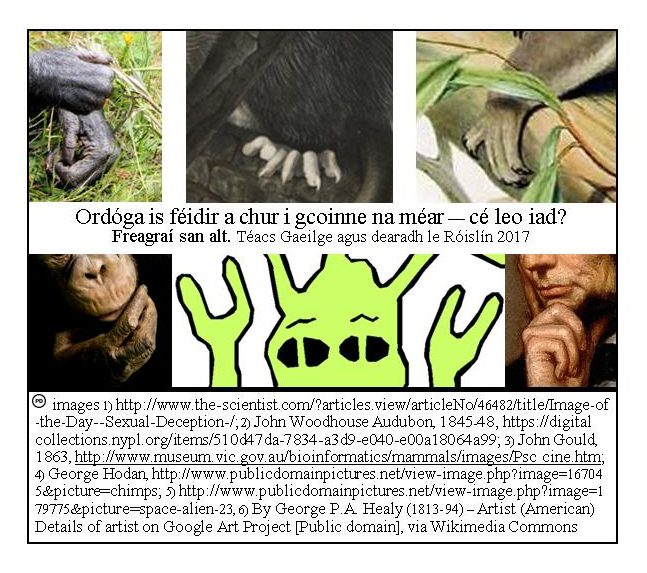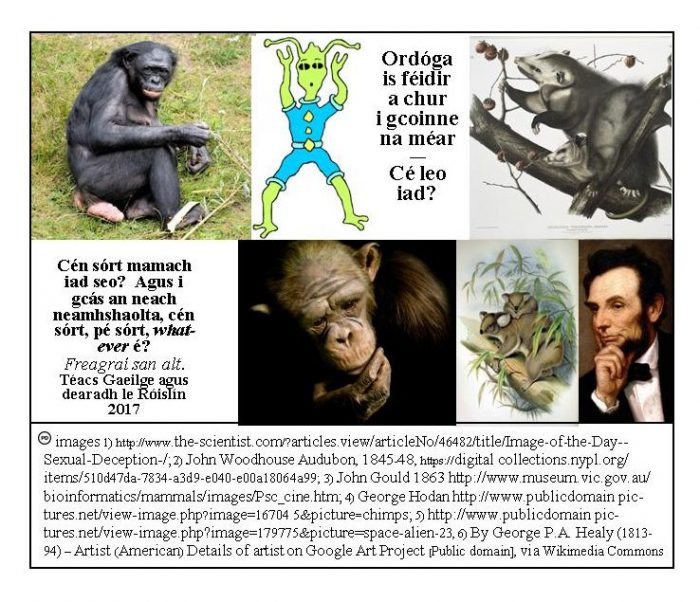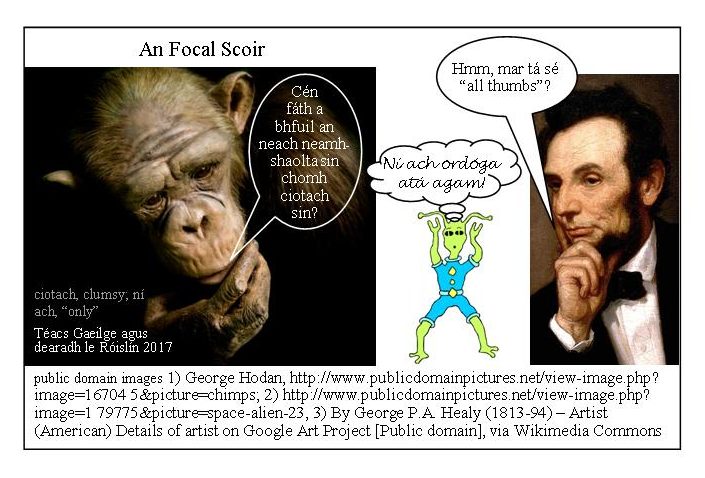A Glossary for the Irish in ‘Neacha Neamhshaolta’ (Tríshúileach / Three-eyed, or Otherwise), Part / Cuid 3 Posted by róislín on Feb 28, 2017 in Irish Language
(le Róislín)
Lately we’ve been looking at some vocabulary from the recent blogposts on the theme of “neacha neamhshaolta” (aliens from outer space). We’ve looked at how many eyes a creature might have (trí shúil, mar shampla) and how to say “antennae” for “aliens” as opposed to an antenna for radio and TVs (i.e. aerial), and yes, they are two different words (aintéiní vs. aeróg, gan a bheith ag trácht ar “chluasa coinín,” ach caithfidh mé a admháil nár chuala mé an nath cainte Béarla sin le fada).
Our third main choice for description, as shown in the recent illustrations, is “opposable thumbs,” and this will be the last in our mionsraith for a while. I know, I know, I could have chosen many other features like the following (with the aistriúcháin available thíos): gainní, braiteoga, súile ar ghais, amharc x-gha, baill an bhéil, rubaill, cosa scamallacha, eiseachnámharlaigh and on the more abstract side, cumhachtaí teileapaiteacha agus cumhachtaí teilichinéiteacha. But “opposable thumbs” looked like fun, plus it gives us a chance to review the basic “ordóg” (thumb). Also, it reminded me of Sissy Hanshaw in Even Cowgirls Get the Blues, with her outsized thumbs, making them even more “opposable” than the standard set that most of us are born with. And according to some predictions of the near future, thumbs will evolve to grow larger (for texting, etc.), while our arms and legs may shrink.
Tricky thing, though, is that Irish has a fairly lengthy phrase for the opposable aspect, not a succinct compound adjective like “opposable” (from the Latin oppōnere, to put, place or set against < ob-, against, on + pōnere, to put, place, or set ). The word has been used in English to describe thumbs since 1833, but I’ve only seen the Irish phrase in relatively recent years. Of course, as it happens, I don’t know any Irish-speaking *príomhacheolaithe, whose conversation would no doubt hinge more on the opposability of thumbs than my everyday comhrá would. As a rule of thumb, of course.
Let’s dispense with “to oppose” first, as the basis of the English adjective “opposable.”
Among the Irish words for “to oppose” are “cur i gcoinne,” “cur in éadan,” and “cur in aghaidh,” each of which is a phrasal verb (in these cases, three-word phrasals), basically meaning “to put against.”
The Irish for “opposable thumb,” as you can tell from the caption in the graphic above, is “ordóg is féidir a chur i gcoinne na méar,” lit. a thumb that [it is] possible to put against the fingers,” more of a descriptive phrase than a concise equivalent, I’d say.
And now for the “thumb” part: ordóg. Here are some of its basic forms:
an ordóg, the thumb
na ordóige, of the thumb
na hordóga, the thumbs
na n-ordóg, of the thumbs
As for na hordóga thuas sa ghrafaic, here are the creatures, person or alien to whom they belong, answering the question “Cé leo iad?” (also in the graphic):
1) mionsiompansaí, bonobo, lit. mini-chimpanzee
2) apasam Virginia, Virginia opossum
3) cóála, koala
4) siompansaí, chimpanzee
5) neach neamhshaolta démhéarach déladhrach, two-fingered, two-toed alien from outer space, lit. otherworldly or unearthly being; and yeah, I’m the one interpreting those fingers as opposable. If I were an alien from outer space with only two fingers per hand, I’d sure as Camazotz want to make sure that those two digits were opposable.
6) Abraham Lincoln, agus staidiúir (a pose) mhachnamhach air
So, sin na hordóga sna sé phictiúr thuas. Sometime soon maybe we’ll segue from neacha neamhshaolta to Lá Fhéile Pádraig, given that some of those neacha neamhshaolta could be the infamous “fir bheaga ghlasa,” previously discussed briefly in this blog (nasc thíos, sa bhlag faoi na béigil). Daichead imir den ghlas do mhí an Mhárta, and all that.
Now that we can imagine a neach neamhshaolta tríshúileach le dhá aintéine agus le hordóga is féidir a chur in gcoinne na méar, perhaps someone would like to design their own alien from outer space and describe it here for others to read. And remember, if you want to describe some other features, there are some suggestions in the glossary below. There are also some links below, for previous blogposts in this mini-series. And finally, because they’re such amazing situations, I’ve included two extra links, one to America’s national “What If Cats and Dogs Had Opposable Thumbs Day” (held annually on March 3rd), yep, dáiríre, and scond, a cat with a seeming opposable thumb. Who knows when I’d ever have another chance to mention those again and still be on topic. On that note, SGF — Róislín
A. Naisc d’iarbhlagmhíreanna:
A Glossary for the Irish in ‘Neacha Neamhshaolta’ (Tríshúileach / Three-eyed, or Otherwise), Part / Cuid 2 Posted by róislín on Feb 26, 2017 in Irish Language
A Glossary for the Irish in ‘Neacha Neamhshaolta’ (Tríshúileach / Three-eyed, or Otherwise), Cuid / Part 1 Posted by róislín on Feb 24, 2017 in Irish Language
Design Your Own ‘Neach Neamhshaolta’ and Describe It in Irish, or, What’s the Gaeilge for ‘I Have Two Antennae, or Three Eyes or Four Opposable Thumbs’? Posted by róislín on Feb 22, 2017 in Irish Language
Cineálacha Frasaíochta (Irish Terms for Types of Precipitation: Rain, Snow, Sleet, Hail) Posted by róislín on Feb 16, 2017 in Irish Language (for the original inchinn neach neamhshaolta in this mionsraith ad hoc).
Béigil: Uaine nó Glas? (Which Type of ‘Green’ for Bagels?)Posted by róislín on Mar 27, 2013 in Irish Language
B. Naisc faoi mhadraí agus faoi chait:
https://www.petcentric.com/02-28-2010/what-if-cats-and-dogs-had-opposable-thumbs-day/
and an apparently real-life cat with a sort of opposable thumb, which turns out to be an example of poladachtaile:
https://www.youtube.com/watch?v=2hngBzDDyFE (Amazing Cat Gives Thumbs Up). Or is this cat a product of CAD — diabhal a fhios agam
gluais: gainní (scales), braiteoga (tentacles), súile ar ghais súile (eyes on stalks), amharc x-gha (x-ray vision), baill an bhéil (mouth parts), rubaill (tails), cosa scamallacha (webbed feet), eiseachnámharlaigh (exoskeletons), cumhachtaí teileapaiteacha (telepathic powers), cumhachtaí teilichinéiteacha (telekinetic powers)

Build vocabulary, practice pronunciation, and more with Transparent Language Online. Available anytime, anywhere, on any device.







Leave a comment: